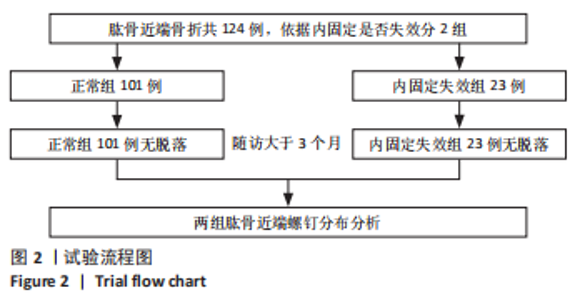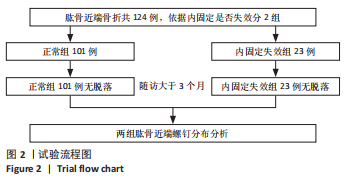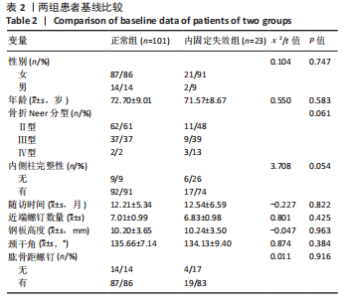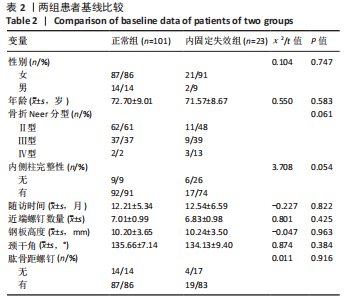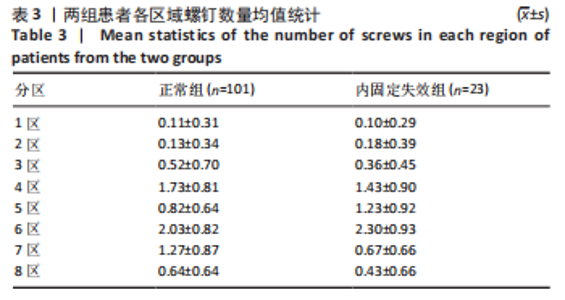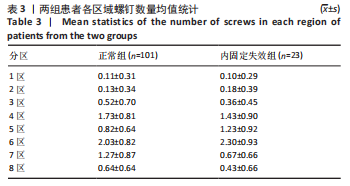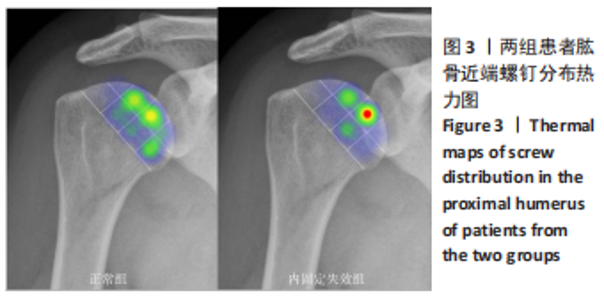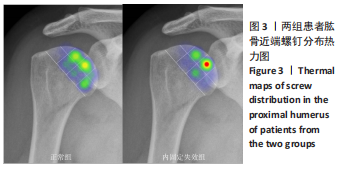Chinese Journal of Tissue Engineering Research ›› 2024, Vol. 28 ›› Issue (24): 3850-3854.doi: 10.12307/2024.621
Previous Articles Next Articles
Distribution characteristics of humeral head screws in treatment of proximal humeral fractures with proximal humerus internal locking system plate
Hu Liuchao1, 2, Luo Yiwen1, 2, Huang Jiewen1, 2, Lan Sibin1, 2, Wu Zhifang1, 2
- 1Third Affiliated Hospital, Guangzhou University of Chinese Medicine, Guangzhou 510378, Guangdong Province, China; 2Guangdong Research Institute for Orthopedics and Traumatology of Chinese Medicine, Guangzhou 510378, Guangdong Province, China
-
Received:2023-06-29Accepted:2023-08-09Online:2024-08-28Published:2023-11-21 -
Contact:Luo Yiwen, MD, Professor, Chief physician, Master’s supervisor, Third Affiliated Hospital, Guangzhou University of Chinese Medicine, Guangzhou 510378, Guangdong Province, China; Guangdong Research Institute for Orthopedics and Traumatology of Chinese Medicine, Guangzhou 510378, Guangdong Province, China -
About author:Hu Liuchao, Master, Attending physician, Third Affiliated Hospital, Guangzhou University of Chinese Medicine, Guangzhou 510378, Guangdong Province, China; Guangdong Research Institute for Orthopedics and Traumatology of Chinese Medicine, Guangzhou 510378, Guangdong Province, China -
Supported by:Research Project of Guangdong Provincial Administration of Traditional Chinese Medicine, No. 20231120 (to HLC); Open Fund Project of Guangdong Academy of Traditional Chinese Medicine Osteopathy, No. GYH202102-01 (to HJW)
CLC Number:
Cite this article
Hu Liuchao, Luo Yiwen, Huang Jiewen, Lan Sibin, Wu Zhifang. Distribution characteristics of humeral head screws in treatment of proximal humeral fractures with proximal humerus internal locking system plate[J]. Chinese Journal of Tissue Engineering Research, 2024, 28(24): 3850-3854.
share this article
Add to citation manager EndNote|Reference Manager|ProCite|BibTeX|RefWorks
| [1] PATEL AH, WILDER JH, OFA SA, et al. Trending a decade of proximal humerus fracture management in older adults. JSES Int. 2022;6(1):137-143. [2] BAKER HP, GUTBROD J, STRELZOW JA, et al. Management of Proximal Humerus Fractures in Adults-A Scoping Review. J Clin Med. 2022;11(20):6140. [3] JAWA A, BURNIKEL D. Treatment of Proximal Humeral Fractures: A Critical Analysis Review. JBJS Rev. 2016;4(1):e2. [4] KAVURI V, BOWDEN B, KUMAR N, et al. Complications Associated with Locking Plate of Proximal Humerus Fractures. Indian J Orthop. 2018;52(2):108-116. [5] LAUX CJ, GRUBHOFER F, WERNER C, et al. Current concepts in locking plate fixation of proximal humerus fractures. J Orthop Surg Res. 2017;12(1):137. [6] MARONGIU G, VERONA M, CARDONI G, et al. Synthetic Bone Substitutes and Mechanical Devices for the Augmentation of Osteoporotic Proximal Humeral Fractures: A Systematic Review of Clinical Studies. J Funct Biomater. 2020;11(2):29. [7] SUN Q, WU X, WANG L, et al. The plate fixation strategy of complex proximal humeral fractures. Int Orthop. 2020;44(9):1785-1795. [8] 汪秋柯. 肱骨近端骨折分型与锁定钢板内固定术后继发性螺钉穿出的关系[D]. 上海:上海交通大学, 2019. [9] LONGO UG, PETRILLO S, BERTON A, et al. Reverse total shoulder arthroplasty for the management of fractures of the proximal humerus: a systematic review. Musculoskelet Surg. 2016;100(2):83-91. [10] LIEW AS, JOHNSON JA, PATTERSON SD, et al. Effect of screw placement on fixation in the humeral head. J Shoulder Elbow Surg. 2000;9(5):423-426. [11] TINGART MJ, LEHTINEN J, ZURAKOWSKI D, et al. Proximal humeral fractures: regional differences in bone mineral density of the humeral head affect the fixation strength of cancellous screws. J Shoulder Elbow Surg. 2006;15(5):620-624. [12] ERHARDT JB, STOFFEL K, KAMPSHOFF J, et al. The position and number of screws influence screw perforation of the humeral head in modern locking plates: a cadaver study. J Orthop Trauma. 2012;26(10):e188-e192. [13] GARDNER MJ, WEIL Y, BARKER JU, et al. The importance of medial support in locked plating of proximal humerus fractures. J Orthop Trauma. 2007;21(3): 185-191. [14] 李波, 张世民, 胡孙君, 等. 肱骨头下皮质外距螺钉重建内侧柱稳定性的三维有限元分析[J]. 中国修复重建外科杂志,2022,36(8):995-1002. [15] MEHTA S, CHIN M, SANVILLE J, et al. Calcar screw position in proximal humerus fracture fixation: Don’t miss high. Injury. 2018,49(3):624-629. [16] REN H, WU L, ZHANG X, et al. The effect of integrity of lesser tuberosity-medial calcar on postoperative outcome in the proximal humeral fracture. J Orthop Surg Res. 2023;18(1):363. [17] PONCE BA, THOMPSON KJ, RAGHAVA P, et al. The role of medial comminution and calcar restoration in varus collapse of proximal humeral fractures treated with locking plates. J Bone Joint Surg Am. 2013;95(16):e111-e113. [18] LEE SH, HAN SS, YOO BM, et al. Outcomes of locking plate fixation with fibular allograft augmentation for proximal humeral fractures in osteoporotic patients: comparison with locking plate fixation alone. Bone Joint J. 2019;101-B(3):260-265. [19] GARDNER MJ, BORAIAH S, HELFET DL, et al. Indirect medial reduction and strut support of proximal humerus fractures using an endosteal implant. J Orthop Trauma. 2008;22(3):195-200. [20] HE Y, ZHANG Y, WANG Y, et al. Biomechanical evaluation of a novel dualplate fixation method for proximal humeral fractures without medial support. J Orthop Surg Res. 2017;12(1):72. [21] PARK SG, KO Y. Medial Buttress Plating for Humerus Fractures With Unstable Medial Column. J Orthop Trauma. 2019;33(9):e352-e359. [22] SOMASUNDARAM K, HUBER CP, BABU V, et al. Proximal humeral fractures: the role of calcium sulphate augmentation and extended deltoid splitting approach in internal fixation using locking plates. Injury. 2013;44(4):481-487. [23] RODERER G, SCOLA A, SCHMOLZ W, et al. Biomechanical in vitro assessment of screw augmentation in locked plating of proximal humerus fractures.Injury. 2013;44(10):1327-1332. [24] 林浩东,傅慧超,吴晓明. 《2021版老年肱骨近端骨折治疗指南》解读[J]. 中华创伤杂志,2022,38(9):6. [25] PADEGIMAS EM, ZMISTOWSKI B, LAWRENCE C, et al. Defining optimal calcar screw positioning in proximal humerus fracture fixation. J Shoulder Elbow Surg, 2017;26(11):1931-1937. [26] 李波, 张世民, 胡孙君, 等. 肱骨头下皮质外距螺钉重建内侧柱稳定性的三维有限元分析[J]. 中国修复重建外科杂志,2022,36(8):995-1002. [27] ZHANG X, HUANG J, ZHAO L, et al. Inferomedial cortical bone contact and fixation with calcar screws on the dynamic and static mechanical stability of proximal humerus fractures. J Orthop Surg Res. 2019;14(1):1. [28] GALLAGHER B, SILVA MJ, RICCI WM. Effect of off-axis screw insertion, insertion torque, and plate contouring on locked screw strength. J Orthop Trauma. 2014; 28(7):427-432. [29] PADEGIMAS EM, CHANG G, NAMJOUYAN K, et al. Failure to restore the calcar and locking screw cross-threading predicts varus collapse in proximal humerus fracture fixation. J Shoulder Elbow Surg. 2020;29(2):291-295. [30] OCKERT B, BRAUNSTEIN V, KIRCHHOFF C, et al. Monoaxial versus polyaxial screw insertion in angular stable plate fixation of proximal humeral fractures: radiographic analysis of a prospective randomized study. J Trauma. 2010;69(6): 1545-1551. [31] FLETCHER J, WINDOLF M, RICHARDS RG, et al. Screw configuration in proximal humerus plating has a significant impact on fixation failure risk predicted by finite element models. J Shoulder Elbow Surg. 2019;28(9):1816-1823. [32] ERHARDT JB, STOFFEL K, KAMPSHOFF J, et al. The position and number of screws influence screw perforation of the humeral head in modern locking plates: a cadaver study. J Orthop Trauma. 2012;26(10):e188-e192. [33] LINDSAY C, HASTY E, CARPENTER D, et al. Proximal Humeral Locking Plates: A Cadaveric Study of 5 Versus 7 Metaphyseal Locking Screws. Orthopedics. 2018; 41(5):306-311. [34] BARVENCIK F, GEBAUER M, BEIL FT, et al. Age- and sex-related changes of humeral head microarchitecture: histomorphometric analysis of 60 human specimens. J Orthop Res. 2010;28(1):18-26. [35] DONOHUE DM, SANTONI BG, STOOPS TK, et al. Biomechanical Comparison of 3 Inferiorly Directed Versus 3 Superiorly Directed Locking Screws on Stability in a 3-Part Proximal Humerus Fracture Model. J Orthop Trauma. 2018;32(6):306-312. [36] CIRIC D, MISCHLER D, QAWASMI F, et al. Secondary Perforation Risk in Plate Osteosynthesis of Unstable Proximal Humerus Fractures: A Biomechanical Investigation of the Effect of Screw Length. J Orthop Res. 2019;37(12):2625-2633. [37] FLETCHER J, WINDOLF M, GRUNWALD L, et al. The influence of screw length on predicted cut-out failures for proximal humeral fracture fixations predicted by finite element simulations. Arch Orthop Trauma Surg. 2019,139(8):1069-1074. [38] SAUL D, HIMMELMANN T, DRESING K. Humeral Tip-apex-distance as a Prognostic Marker for Proximal Humeral Fractures in 203 Patients. Open Orthop J. 2017; 11:297-308. [39] SPROSS C, JOST B, RAHM S, et al. How many radiographs are needed to detect angular stable head screw cut outs of the proximal humerus - a cadaver study. Injury. 2014;45(10):1557-1563. |
| [1] | Wang Mingming, Zhang Zhong, Sun Jianhua, Zhao Gang, Song Hua, Yan Huadong, Lyu Bin. Finite element analysis of three different minimally invasive fixation methods for distal tibial fractures with soft tissue injury [J]. Chinese Journal of Tissue Engineering Research, 2024, 28(6): 879-885. |
| [2] | Yan Huadong, Zhang Zhong, Zhao Gang, Li Jie, Song Hua, Sun Jianhua, Liu Zhi, Wang Mingming. Biomechanical difference of different fixation methods in bone healing of distal tibial comminuted fractures analyzed by finite element method [J]. Chinese Journal of Tissue Engineering Research, 2024, 28(24): 3814-3821. |
| [3] | Yang Fangjun, Wang Fuyang, Su Yun, Wang Yongze, Yang Cunheng, Wang Tienan. Finite element analysis of intramedullary nail and locking plate fixation for proximal humeral fractures [J]. Chinese Journal of Tissue Engineering Research, 2024, 28(21): 3313-3318. |
| [4] | Wu Taoguang, Nie Shaobo, Chen Hua, Zhu Zhengguo, Qi Lin, Tang Peifu. Biomechanical characteristics of a new multi-dimensional cross locking plate in the treatment of subtrochanteric nonunion [J]. Chinese Journal of Tissue Engineering Research, 2023, 27(9): 1330-1334. |
| [5] | Yin Hao, Chen Guang, Li Yan, Zhou Enchang, Ning Rende. Finite element analysis of dorsal Kirschner wire for enhancing the stability of the dorsal ulnar fracture fragment in AO C type distal radial fractures [J]. Chinese Journal of Tissue Engineering Research, 2023, 27(31): 4921-4925. |
| [6] | Ma Tianyong, Wang Dewei. Finite element analysis of middle clavicle fracture with ortho-bridge system intramedullary fixation [J]. Chinese Journal of Tissue Engineering Research, 2023, 27(29): 4599-4606. |
| [7] | Liu Tao, Zha Mingjian, Ke Rongjun. Comparison of the third generation multiloc intramedullary nail, common curved intramedullary nail and proximal humeral locking plate in the treatment of complex proximal humeral fractures [J]. Chinese Journal of Tissue Engineering Research, 2023, 27(22): 3537-3543. |
| [8] | Zhao Yuhang, Yang Zhaohui. Surgical versus conservative treatment of volar Die-punch fractures of the medial column of the distal radius: who can get a more stable wrist joint? [J]. Chinese Journal of Tissue Engineering Research, 2023, 27(22): 3544-3549. |
| [9] | Liu Yan, Ge Hongqing, Chen Wenzhi, Liang Zeqian, Li Junye, He Jielong. Finite element analysis of different fibular support methods to reconstruct the poor medial column of humeral proximal fractures [J]. Chinese Journal of Tissue Engineering Research, 2023, 27(18): 2804-2808. |
| [10] | Zhang Xinlong, Ci Wentao, Luo Kaiwen, Yan shi. Internal fixation failure after proximal femoral nail antirotation: causes and reoperation strategies [J]. Chinese Journal of Tissue Engineering Research, 2022, 26(6): 973-979. |
| [11] | Peng Kun. Improvement of the treatment effect of osteoporotic fractures: research status and strategy analysis [J]. Chinese Journal of Tissue Engineering Research, 2022, 26(6): 980-984. |
| [12] | Zhang Qiang, Wu Zongde, Liu Liang, Wei Guohua, Peng Liang. Finite element analysis of medial and lateral locking plates for fixation of externally rotated spiral fractures of the lower tibia [J]. Chinese Journal of Tissue Engineering Research, 2022, 26(36): 5750-5754. |
| [13] | Xu Zhi, Zhong Hehe, Xiang Hao, Li Enchao, Huang Yushun, Lu Hao, Jin Ying, Zou Gang, Liu Yi. Finite element analysis of three internal fixation methods for treating femoral shaft fracture [J]. Chinese Journal of Tissue Engineering Research, 2022, 26(33): 5271-5277. |
| [14] | Liu Jiangfeng. Nano-hydroxyapatite/polyamide 66 composite filling combined with locking plate in the treatment of fibrous dysplasia of femoral bone [J]. Chinese Journal of Tissue Engineering Research, 2021, 25(4): 542-547. |
| [15] | Zhang Tianyi, Mao Kaige, Dong Wei, Li Lixin, Kong Fanlin, Zhu Jun, Fan Guofeng. Which is more suitable for conversion to hip arthroplasty after failure of dynamic hip screws or proximal femoral nail anti-rotation for stable intertrochanteric fractures in the elderly? [J]. Chinese Journal of Tissue Engineering Research, 2021, 25(33): 5335-5340. |
| Viewed | ||||||
|
Full text |
|
|||||
|
Abstract |
|
|||||
